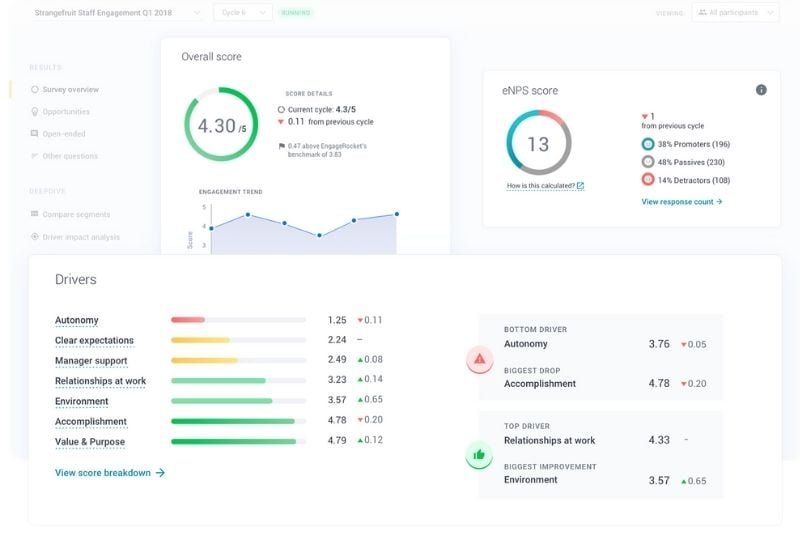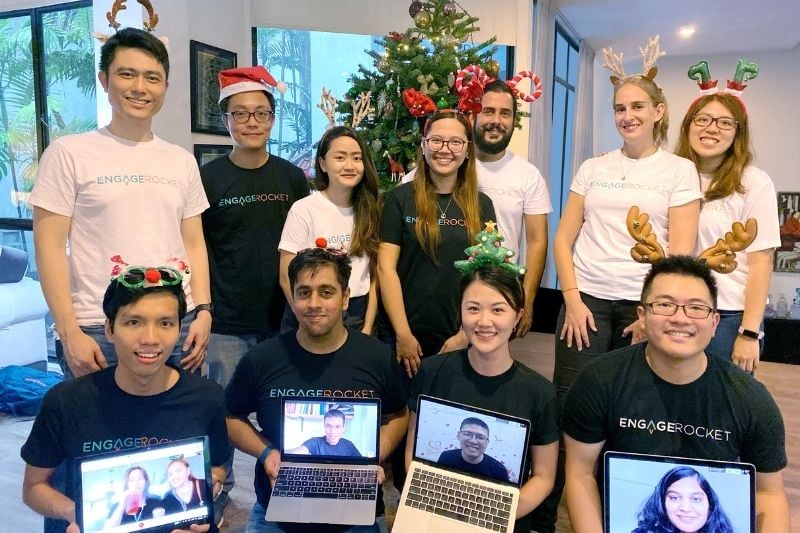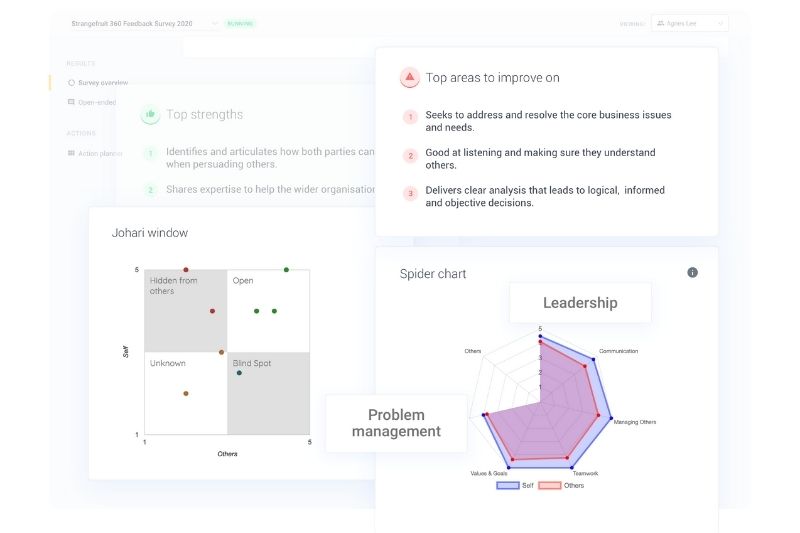Employee engagement is crucial if you’re looking to increase profits and productivity. Keeping your employees happy is one thing, but to take that next step in growing your business, employee engagement has to be one of your top priorities.
CheeTung Leong, founder and CEO of HR tech startup EngageRocket, knows a thing or two about employee engagement. Before EngageRocket, CheeTung worked as a regional director and managing consultant at American research and consulting company Gallup for almost five years. With over a decade of experience in the employee engagement space under his belt, he’s also designed more than 100 employee engagement programmes for different companies of various sizes all across Southeast Asia.
We sat down with CheeTung to discover his simplest approaches to increasing employee engagement, and learn more about the biggest mistakes companies make when it comes to employee engagement (and how to avoid them). For those looking to drastically improve their employee retention rates, productivity levels, and bottom-line, take note!
Hi CheeTung. Let’s start with a simple question: how would you define employee engagement?
If we aren’t too academic about it, it’s really just two things: It’s the ability to be motivated and productive at work; to be willing and able to do a job right. Quite simple, but not so easy to do.
Can you explain to us why employee engagement is important?
I see employee engagement as the fundamental responsibility of management.
As a team leader, a manager, or a company leader, your main goal is to ensure that the team that works with you is productive. If they’re not motivated, then you really are just a guy trying to do his own thing, and so it’s really important just from that philosophical angle. Statistically, there are a lot of studies that show just how important employee engagement is. Studies conducted by Gallup show employee engagement can actually be responsible for up to 21% improvement in profitability and productivity.
In our own studies at EngageRocket most recently within the COVID-19 period, we’ve found that people who are engaged are actually five times more likely to be resilient in their companies and twice as likely to not be stressed by everything that’s going on around them.

Since COVID-19 has rendered many employees unable to work at their offices, how can businesses keep employees productive at home given all the surrounding distractions and constraints?
The number one thing to do is to hear them out and listen to what they’re telling you. There are some employees, parents of young children, who will say: From 12 pm to 5 pm I can’t work, I can’t take meetings, I can’t do anything because my kids are at home, or I need to pick them up from school, or I need to look after their home-based learning. The team leader needs to be able to structure work schedules around that and help them find an arrangement that makes sense.
But it’s not just parents of young children, it’s also people who might struggle because the home environment simply isn’t very conducive. We’ve seen leaders sponsor things like noise-cancelling headphones or ergonomic chairs to help their people work better. So step one would be to listen to people, and then step two is to think about how we can match what we’re hearing from our people with what needs to be done at work.
Every company probably tries to implement some form of employee engagement, but obviously not every company can be successful in doing so. What is a common mistake that companies make when trying to keep employees engaged?
The biggest mistake is thinking that employee engagement is the same as employee happiness because there’s quite a subtle distinction. You can have very happy employees who are sitting around, going for two-hour lunch breaks every day, chilling out, but they’re unproductive. They’re not motivated either so they’re just happy.
When it comes to employee engagement, companies often forget that it’s not about making your employees happy. It’s about finding ways to motivate them and keep them productive. One of the things we’ve seen in the research that not many leaders know, is that 70% of employee engagement is actually driven by immediate managers and supervisors at all levels of an organisation.
What companies need to do is not to spend more money on company dinners, gala meals, or employee benefits, because what really helps is equipping, training, and holding managers accountable for being able to improve the motivation levels and the productivity levels of their people.
Let’s talk about your company. How does EngageRocket help businesses improve their employee experiences across the entire employee lifecycle?
The number one thing that we do is help companies listen to their employees better.
Companies do all kinds of employee surveys when you’re a candidate or after you join the company, things that are on an ongoing basis like climate surveys. However, there is very little ability to make sense of all of this information because they’re all in different silos, and nobody’s really trying to connect the dots.
What EngageRocket does, as a single source of truth, is that we are a surveying platform that companies can deploy. We cover a wide range of surveys, whether it’s peer reviews, performance feedback, employee engagement surveys, or post-training evaluations, and we put all of this data together within a single database. The responses are confidential in some of the surveys meaning nobody in the company knows who said what specifically, but on our backend, we actually store all that information together with other information about those employees in terms of demographics and so on.
From there, we’re able to produce reports that help HR, team managers, and company leaders get a better sense of their organisational health and productivity at any one point in time. We help them understand what levers they can pull to motivate their people better and result in more productivity.

How often should employers seek to communicate with their employees?
There are three key management mechanisms, as I call them, that are vastly beneficial in terms of building an engaged team.
The first one is daily check-ins. Just checking in with your team every day to see what was done the day before and what’s going to happen in the upcoming day. You might want to ask if there are any blockers or barriers that could potentially prevent them from fulfilling their tasks. With the daily check-ins, managers can actually start aligning the team’s efforts to the goals of the whole team rather than focusing on individual goals. Just doing something as simple as this not only improves productivity, but it also improves motivation, because employees like to feel that their managers are actually solving problems for them.
The second mechanism that we find the best managers use is called the management one-on-one. This is a one-on-one meeting between the manager and an employee that is pre-scheduled. Typically, we find the best kind of frequency for this is once every two weeks or maybe once every month. For smaller teams, once a week is still possible but that’s not always realistic for everyone.
During these meetings, the agenda should belong to the employee, and the purpose of these meetings is that the manager keeps this time open for the employee to ensure that certain things that don’t come up in regular operations like their professional development plan or any personal issues can potentially surface. It’s basically an outlet for management to help their employees as people.
And the third point is pulse surveys, which are starting to grow in popularity. Pulse surveys are short, high-frequency surveys that are sent out at a cadence that makes sense operationally. For a small team, this could be monthly. For larger organisations, this might be quarterly, as they do quarterly business reviews. As companies plan business actions around, for example, inventory levels or upcoming marketing campaigns, they can then also start planning actions based on the data they’re seeing from their people on what needs to be changed.
Can you touch on whether you think feedback should be anonymous or identifiable?
For most Asian organisations, the levels of trust in management just aren’t high enough yet to have completely identifiable responses from employees. I would still recommend most Asian organisations to keep their surveys perhaps not anonymous but confidential, so no one in the company is able to identify who said what.
What EngageRocket has found to be quite useful is to have a mechanism for truly anonymous follow-up chats. For example, if you’re my boss, and I made a comment that I wanted more work-life balance, you can actually anonymously clarify with me without knowing who I am by opening a chat window in the EngageRocket system between the two of us. You, as the manager, wouldn’t know who I am, but obviously, I know who my manager is.
So if I wanted more work-life balance and say, more time at the end of the day to go pick my daughter up from childcare, perhaps I might ask: Can I come in earlier and end work earlier? And as a manager you could say, sure, please go ahead and do that. Problem solved. You don’t always need a ton of digging and analysis to fix an issue that you could have solved with one anonymous conversation.

How should companies best foster and support the professional development of their employees?
It’s important for companies to segregate professional development from training. Recently, I was speaking to a CEO of a relatively large company, and we were talking about professional development. He told me, “Every year we send everybody for 40 hours of training. 92% of our people are clocking these 40 hours or more, and they’re getting plenty of professional development.”
I think that mindset is really getting in the way of true professional development. If you look at traditional adult learning models, there is a 70/20/10 rule where 70% of learning comes from on the job learning, 20% comes from coaching and mentoring and other people, and 10% comes from structured classroom learning. The 10% needs to support everything that’s happening in the 70% and the 20%. If the 10% is irrelevant to their job or if it’s something else that they don’t even have to deal with on a daily basis, then it just becomes a period for people to go in and not pay attention.
On top of that, designing the right kind of competencies that are required for the jobs and letting people progress and understand how they will progress is really important. Giving senior managers the right skills to be able to coach and mentor is crucial because learning how to step in strategically, ask the right questions, and provide the best guidance accelerates their learning so much more. Then, when you insert that 10% of structured learning in at the right time, that ends up driving much better professional development than what we see in a lot of companies today.
How can companies who are welcoming new employees during this difficult time make them feel more welcome?
One of the things that we found worked well is to equip all hiring managers with the knowledge of what it means to onboard new team members. That might seem obvious, but sometimes HR or talent acquisition leaves it to chance. One of the things they can do is to establish a structured orientation program. In some companies, this could last just a day, in other companies they could go on for two weeks to a month.
During these orientation programs, hiring managers should be very deliberate about connecting the new hire with others that they’re going to be working with, by making sure that there are enough one-on-one touchpoints in the first few weeks. These one-on-one sessions allow new employees to check in and verbalise how they’re doing or whether they’re feeling lost about anything. Just taking that extra effort to be sure that they get to meet as many people as possible will help them slowly begin to build their own networks within the company, but that sense of belonging and camaraderie needs to start from day one.
The second thing that can help is if the hiring manager gives a small assignment within the first couple of weeks that requires this new hire to go work with other people, whether it’s information gathering or delivering something. This also helps new hires find their feet and to start building those ties with other people on the team.
The third thing that’s important to do, and sometimes forgotten, is to just be inclusive and make sure that this new hire is part of workflows. For example, since the new employee wasn’t around before, it’s quite easy for people to organise events and accidentally exclude them, like setting up virtual happy hours and forgetting to invite them. The hiring manager needs to be aware of this and ensure that the new hire is not left out.

Looking ahead, what are some trends you see in employee engagement over the next few years?
Firstly, I think that we’re going to see a greater alignment of employee engagement understanding with the overall employee experience and overall business objectives. As a result of COVID-19, businesses are now faced with a situation where we need to be cognizant of what’s going on with our employees and how they’re thinking. I believe that the levels of awareness around the need to not only make employees happy, but also to keep them engaged, is going to increase.
Secondly, for leaders to keep their employees engaged effectively and at scale, there will need to be a greater deployment of technology; more digitalisation in understanding employee engagement. With that, a greater focus will be placed on what we call people analytics, or the ability to analyse that information effectively to derive actionable insights.
Finally, I am also seeing a move towards more agile methods of driving employee engagement. Instead of what used to be the norm – a company would run a survey every two years, try to understand what they need to do for the next two years, and action plan around that – companies are now in a situation where they need to be much more responsive to the employee and talent base in response to the pace that business is now moving at.
More about EngageRocket
Founded in 2016 by CheeTung Leong and Dorothy Yiu in Singapore, EngageRocket assists businesses and business leaders in making better people decisions by providing helpful data derived from different types of surveys. It is currently Asia’s largest survey software company, and has been featured in multiple publications, including Forbes, Business Insider, and The Straits Times, and deployed by companies such as Sephora, Rakuten, and StarHub.

CheeTung Leong, Founder and CEO of EngageRocket
Related Articles
12 Reasons Why Diversity is Important in the Workplace
Employee Pulse Survey: How You Can Increase Your Employee Engagement





